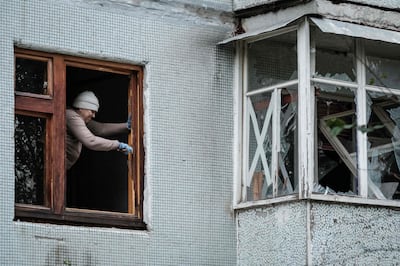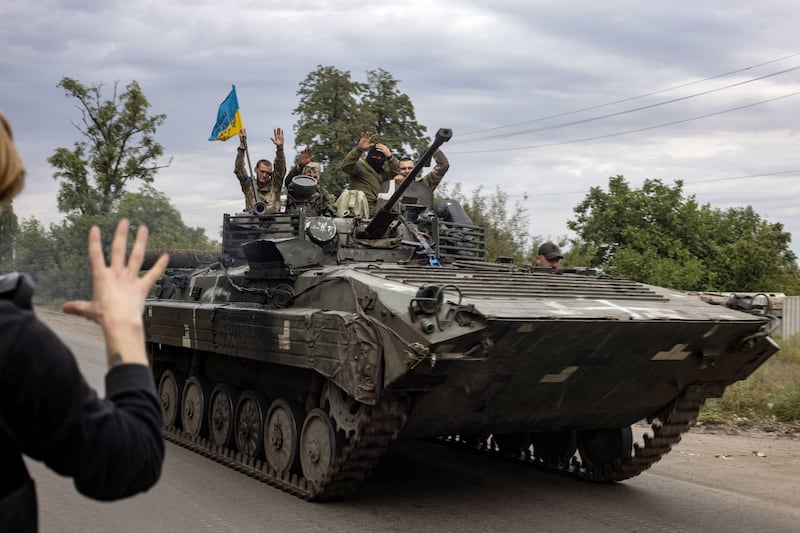Fifteen kilometres north of Kharkiv city and a stone’s throw from the Russian border sits the Ukrainian village of Dementiivka. Home to a hundred people and barely a speck on the map, you might miss it even if you drove straight through it.
But its location along the lone highway linking Belgorod, the nearest Russian city, to Ukraine’s second-largest city makes it a potentially crucial node on any planned Russian supply line.
Control Dementiivka – which Ukrainian soldiers have taken to calling “Devil Village” because the name is much like the Ukrainian word for “demented” or “devilish”, and because of the brutal fighting there – and you could control access to Kharkiv and the north-east.
Places the world had never heard of – Bucha and Irpin, Izyum, Dementiivka and more – have been playing an outsized role in the conflict. Russian forces took Dementiivka in March, soon after the war began. In spring, a Ukrainian battalion launched a number of assaults on the town before a night-time mission through the forest succeeded in driving the Russians out. But in late June, the town changed hands yet again.
“We held Devil Village for a couple months, then the Russians took it back,” 33-year-old Artem Ryzhykov, lead drone operator in the unit, told me on a Zoom call last week from his unit’s position near the Russian border. “They sent thousands of tonnes of grenades and artillery and destroyed the whole village. It was impossible for us to stay.”
Putin: Russia to support referendums in Ukraine's regions

I’ve known Mr Ryzhykov for nearly a decade and in peacetime he’s a meticulous, award-winning documentary filmmaker and cinematographer. I was unable to independently verify his account, but much of it is aligned with reliable reporting from the area.
After the Dementiivka defeat, his battalion pulled back from the front line for several weeks of training and recruitment. Then one morning early this month, as the Kharkiv counter-offensive kicked into gear, he and his team were sent to join an artillery unit a few kilometres south of Dementiivka.
After receiving word that the Russians were in rapid retreat and their side had retaken Devil Village, they rushed over and were the first to arrive after the spearhead force that pushed the Russians back. “They left everything. They pulled out in minutes; I even found hot soup,” Mr Ryzhykov said, recalling the stolen cars and appliances. “It was like a market in the middle of the forest: you see 10 refrigerators, 10 washing machines.”
They also left a stunning amount of weapons and heavy equipment, which Ukrainian forces reclaimed. But how, after months of grinding attrition, had Ukraine suddenly achieved its most meaningful battlefield victory almost since the start of the war?
Several factors seem to have turned the tide. The first may have been a massive shift in morale and capabilities. Russia’s spring advance had been led by spetsnaz, or Special Forces, which have a reputation for being smart, tough and battle-tested.
But by late summer, the Russian fighters seemed less experienced and fatigued, amid reports of desertions and a Russian paramilitary group recruiting convicts from prison to fight in Ukraine. This week, Russia’s parliament approved longer jail terms for refusing military service and the government announced a partial military mobilisation. Russian forces may have also been short on weapons after Ukrainian strikes, thought to be aided by US intelligence, took out several Russian arms depots.
In contrast, Ukraine worked all summer to expand and strengthen its mainly civilian territorial defence, aided by social media. Mr Ryzhykov runs his battalion’s Facebook page and says he receives loads of new applicants every day and mostly turns them away. “One good fighter is better than 10 useless guys,” he said.
In July, Mr Ryzhykov’s commander tasked him with finding the 100 worst soldiers in the 1,000-troop battalion. He queried colleagues about problem soldiers while a tech-expert colleague scoured Facebook for posts from battalion members that revealed positions, showed dead Ukrainian soldiers, or expressed frustration with Ukraine’s military.
“We fired all of the crazy and unreliable soldiers and assembled a team of only professional fighters,” said Mr Ryzhykov. “The quality of warriors is much better.”
Finally, the impact of advanced western weaponry has been unmistakable. The Russian side used to be able to lob many more, and more powerful, strikes. But a number of expert reports assert that the imports, including Himars rocket launchers, M777 Howitzers and Finnish 120mm mortars, have all but levelled the playing field in recent weeks.

Yet in retreat, the Russians left behind obstacles for their pursuers. On the day after Ukrainian forces retook Devil Village, Mr Ryzhykov’s commander, mentor and friend, known as Phantom, stepped on a mine in the forest on the edge of town and was badly injured. He’ll need several surgeries, but his fellow soldiers hope he’ll be able to return to service.
Other members of the unit have since been injured by anti-personnel mines, which Russian forces in eastern Ukraine are thought to have placed in the thousands. They’ve been found throughout retaken areas of Kharkiv oblast and could emerge as a problem in other Russian-occupied regions as well.
Mr Ryzhykov is now using drones to help sappers find and defuse the mines to clear the way for Ukrainian forces to move fully into the reclaimed areas, which run all the way to the Russian border. News coverage of the war tends to highlight bombings and battles in cities such as Kherson, Kharkiv, Mariupol and Odessa, though the vast majority of the fighting and dying happens in rural areas.
Every week, dogged, bloody battles are waged over sleepy villages, beyond the view of analysts and reporters. The focus is likely to continue to be on population centres, and for good reason – that is where most people live.
Yet in the end, it may well be what happens in unremarkable places like Devil Village, far from the eyes of the world, that determines the outcome of this war.





